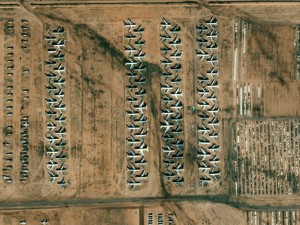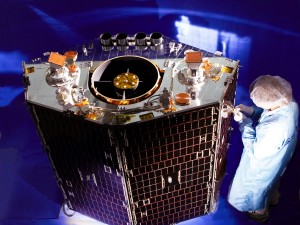KAREN NOZIK / FREELANCE WRITER/ WWW.LINKEDIN.COM/IN/KARENNOZIK
The amount of data being collected from satellites is extremely high and continually increasing, putting severe pressure on downlink providers. Satellite operators have been using the Radio Frequency (RF) spectrum for decades, which has a finite amount of spectrum available, and the demand for it is insatiable.
As increasing numbers of companies and countries are sending up their own systems, data demands continue to increase. The number of satellites alone is astounding. According to Euroconsult, about 3,600 SmallSats are predicted to launch in the next 10 years, the majority of them for Earth observations (http://www.euroconsult-ec.com/7_July_2016). With the Earth Observation (EO) and communication satellites all using the RF spectrum for downlink, and now add the unmanned aerial vehicles (UAVs) sending live streaming video to facilities globally, demand has never been higher.
In addition, there is continued pressure for decreased latency (near real-time delivery). In the event of natural and manmade disasters, where rapid humanitarian aid can save lives, or locating pirates at sea who often have hostages who need aid as fast as possible, transmission speed means everything.
The overcrowded RF airwaves are also prone to interference, interception or jamming. RF transmissions have data transfer speeds of approximately only 200 Mbps (megabits per second), and yet the RF spectrum is one of the most valuable commodities on earth. Since July 1994, the FCC has conducted 87 spectrum auctions, which raised over $60 billion for the U.S. Treasury. Information and its timely transport are critical to national security, disaster response, and commercial customers; assured communications is a must.
Fortunately, there is now in place a reliable, efficient, and affordable solution to move data at an order of magnitude faster using Laser Communication Terminals (LCTs), which also resolves the issues with the current RF spectrum.
LCT TECHNOLOGY
Laser communications (optics in space) has been considered for space applications since the invention of the laser. The attraction has always been the fact that wavelengths in the optical regime are shorter by a factor of 10,000 compared to RF wavelengths. The shorter wavelength results in a smaller diffraction spot compared to traditional RF communication options, leading to smaller optics versus larger RF antennas. The narrow optical beam width makes optical communication links the ideal candidate for point-to-point links.
SECURITY OF LASER COMMUNICATIONS VS RADIO FREQUENCIES
Sending data with lasers, rather than via RF, has the potential to revolutionize the way satellite providers deliver data worldwide. Laser communications transmit information through a data stream of narrow beams of energy that is virtually undetectable and very difficult to jam, due to the coded acquisition signal and coherent detection. To disrupt a laser communication transmission, one would have to be able to detect the narrow beam and find a way to put an object in front of it. To actually intercept data, an adversary would have to place a receiver in its path. The vulnerability to link disturbances through a third party adversary is drastically reduced. Jamming an optical
inter-satellite link is almost impossible.
In addition, there are no regulations for the use of the optical spectrum, which is not the case with RF communication bands. The filing process for RF spectrum-use approval through the International Telecomunication Union (ITU) is long and difficult and success is not guaranteed.
BACKGROUND OF LASERS IN SPACE
Tesat-Spacecom envisioned this capability with lasers decades ago, and with persistent technological advancements, a quantum leap has been made in bandwidth. See Figure 1. As of October 2016, the Tesat LCT 135 is the only functioning commercial laser communication terminal that has been space-tested and rated TRL9 (Technology Readiness Level 9, the highest rating). See Figure 2.
Celebrating 10 years of lasers in space, Tesat’s laser communications journey began with the 2007 launch of U.S. Air Force NFIRE and Infoterra’s TerraSAR-X. Both LEO (Low Earth Orbit) satellites were equipped with first generation Tesat LCTs on board. These LCTs demonstrated optical communication links at a data rate of 5.6 Gbps at LEO-to-LEO distances.
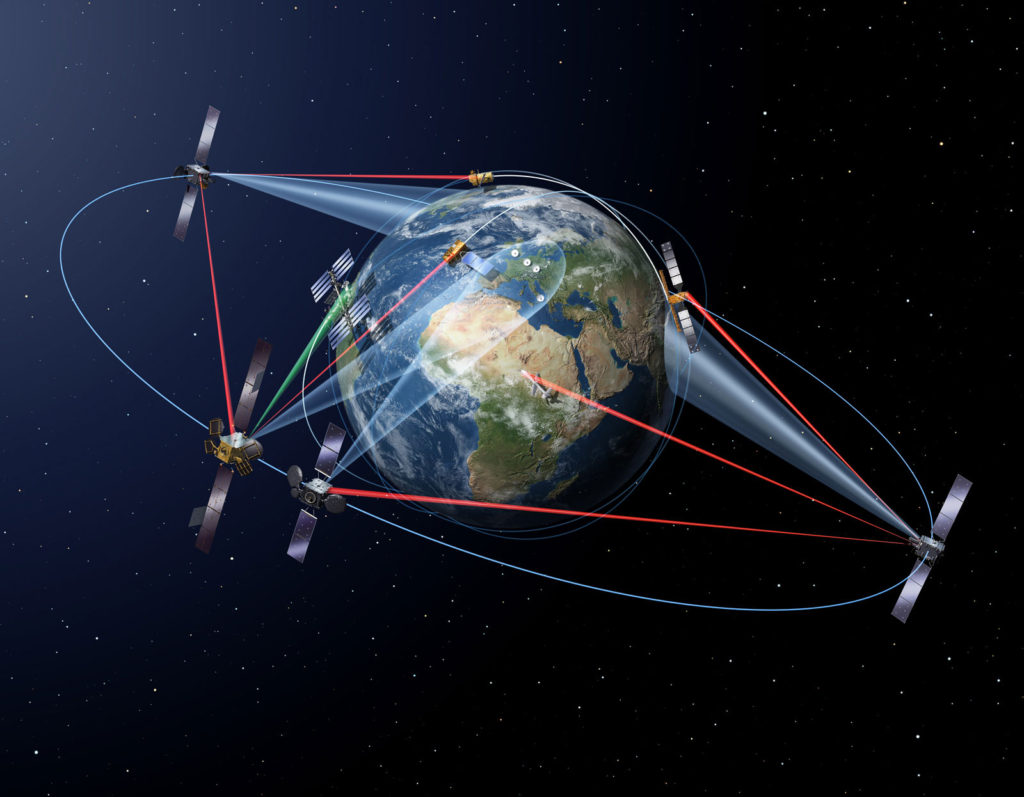
FIGURE 1 Inter-satellite laser links

FIGURE 2 LCT 135
Since 2008, LEO-to-LEO communication links and LEO-to-Ground communication links were successfully achieved. The first-generation LCTs helped refine the basic functionality of the pointing, acquisition and tracking (PAT) aspects of optical communications. The second-generation LCT currently in operation is designed to be used for large distances such as data relay systems. In this role, bi-directional data rates of 1.8 Gbps have been achieved over LEO to GEO (geostationary orbit) distances of up to 45,000 km. The second-generation LCT design is an enhancement of the first generation to enable it to cover the distance between LEO to GEO, GEO to GEO and GEO to Ground.
CURRENT IN-ORBIT STATUS
Currently Tesat has two GEO LCTs and four LEO LCTs from Tesat operating in orbit. Since 2014, LEO to GEO communication links have been demonstrated continuously using the Technology Demonstration Terminal on Alphasat. See Figure 3. In November 2016, after finishing the in-orbit-commissioning phase of the GEO Spacecraft EDRSA, the commercial data relay service known as SpaceDataHighway became operational. In-orbit testing demonstrated a robust design with solid link margins. See Figure 4.
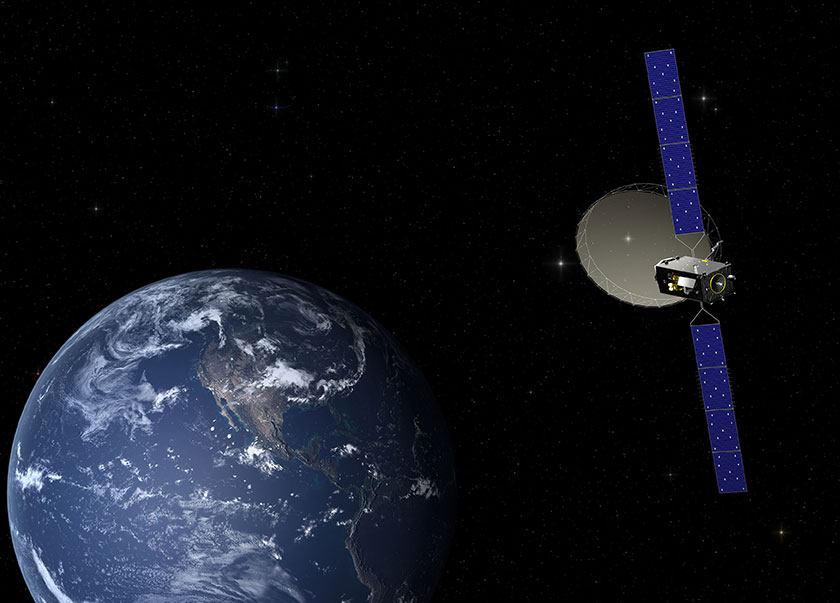
FIGURE 3 Alphasat in Orbit

FIGURE 4 Integration of laser terminal into EDRS A
Based on these in-orbit tests, it became apparent that the LCT can cover distances up to 80,000 km and therefore is well suited to also support longer distances as required for GEO-to-GEO links. This is a significant development, and shows that creating a GEO fiber optic “backbone in space” is possible.
The Tesat LTCs are the basis for the European Data Relay System (EDRS), which provides LEO-GEO data relay services of 1.8 Gbps. Sentinel-1 as part of the European Commission’s Copernicus program is a SAR (Synthetic Aperture Radar) satellite used primarily for maritime domain awareness. See Figure 5. It was the first satellite in LEO to use the EDRS SpaceDataHighway. The satellite dumps its data down to European ground stations, then once it passes them, it switches over to the EDRS Data Relay System. This doubles the capacity of possible data collection and reduces data latency, just by using different downlinks.
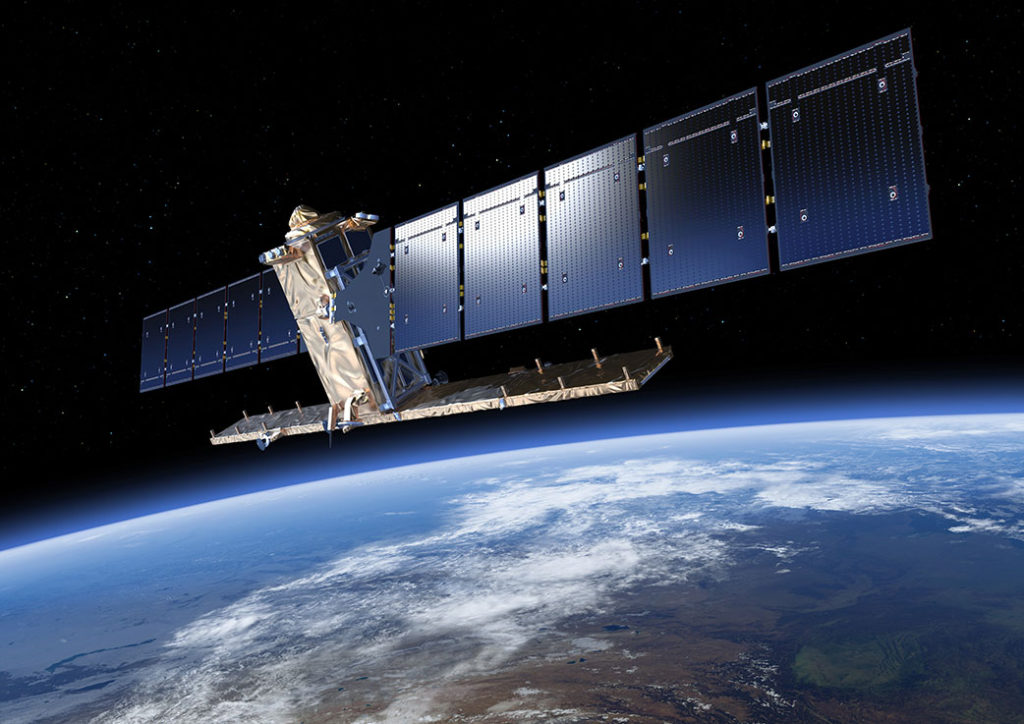
FIGURE 5 Sentinel-1

ANDREAS HAMMER
TESAT CEO
Andreas Hammer, Chief Executive of Tesat, knows well about the aforementioned challenges, and perhaps even more about solutions. He says his biggest challenge is making others understand. He states, “When it comes to space, there is resistance to new technology. But with data constantly growing and an insatiable drive for faster information, the benefits of LCTs become manifest.”
Even though Tesat has been working on LCT in space for over thirty years, laser communication is still considered new. Those who have been dependent on RF technology – just about everyone – are comfortable with the technology theyíve been using, and are slow to accept the new capabilities.
“They (commercial industry) have stayed with the current rate and frequency for decades and they’ve been fine with it,” explains Hammer. “So there is a lot of convincing in the very beginning to overcome these kinds of hurdles, and for the market to understand the benefits of laser.” But change is coming fast and a laser relay system is quickly catching on.
THE BOTTLENECK FOR DATA DOWNLINK
Currently, the RF spectrum is limited. Satellite sensors and instruments are collecting more data than they can transfer off the satellite in a timely manner, using the current legacy RF spectrum. Some operators are filing with the ITU to move to Ku- or Ka-band, but those bands are not secure and at risk of jamming and of data being intercepted. Also, data rates are in the Mbps, while current laser communications offer much higher capacity, of 1.8 Gbps, with even higher data rates coming.
DATA RELAY DECREASES DATA LATENCY
Another problem with the current downlinks is data latency; it takes too long for the data to reach the ground and end users. Optical data relays help to reduce this delay. We have all heard this before over the years, so let’s look at specifics, and how this is different. Using laser beams to transfer data is a game-changer.
Currently, with two GEO LTCs (on Alphasat and EDRS A), and four LEO LTCs (on the original NFIRE and TerraSAR-X, plus two Sentinel satellites) operating in orbit, instead of waiting to pass over a fixed-location ground station, satellites in LEO can transfer their data to these GEO satellites via lasers, which in turn transfer it to the ground via Ka-band. The transmission time window from GEO to the ground is perpetual while the typical LEO link to a ground station is finite. Also, the data rate through the Laser relay is significantly faster at 1.8 Gbps.
The link to the GEO node would be via laser communications, while the link to ground is still via RF (Ka-band). In the near future, these links to the ground will be a combination of laser beams and RF, to take advantage of the most efficient downlink options depending on geographic location, atmospheric distortions, and specific needs of the satellite operators.
Absolute minimum latency is needed for ad-hoc services for monitoring events or disasters. An incredibly low latency of 10-15 minutes is possible with space data relay, in some cases. The EMSA (European Maritime Surveillance Agency) has a requirement to process the data from the sensor of the LEO S/C to the Mission Operation Center in Lisboa/Portugal within 15 Minutes – this can only work with data relay. This is truly “near real-time,” the definition of which has changed drastically in the past few years, from days to hours and now to minutes.

FIGURE 6 LCT Product Portfolio
THE ONLY CHALLENGE: THE CLOUDS
Just as electro-optical sensors taking Earth imagery from satellites cannot “see through clouds,” laser communication links cannot transfer data through clouds due to distortions. This is not a problem for the lasers operating from satellites in LEO to those in GEO, or LEO to LEO, as they are all operating above the atmosphere. This is only an issue for getting data down to Earth, which is why RF is still used for this last step.
However, using lasers for getting data to Earth is being demonstrated. Approximately 900 links from NFIRE and TerraSAR-X have been sent to optical ground stations in Hawaii and Mount Wilson. Potential solutions to improve the groundlink performance are adaptive optics, such as the Transportable Adaptive Optical Ground Station (TAOGS, which is in operation in Tenerife Island, Spain. This TAOGS is terminating the bi-directional 1.8 Gbps link from GEO Alphasat. Another measure to improve the availability for optical ground links is site diversity with more locations around the globe.
CONCLUSION

MATTHIAS MOTZIGEMBA
TESAT VP
Hammer drives his points home. “Tesat is the ‘one stop shop’ for laser communication solutions. We have a wide range of laser communications products from 10 Gbps over 2000 km to 1.8 Gbps over 80,000 km. We are working with manufacturers to ensure their future equipment can utilize laser technology. We are able to industrialize production. You can use our network, or you can build your own. We are a well-known player in the established space market. We are now addressing a low-cost approach in the NewSpace market. Therefore, we now also offer the smallest 100 Mbps Cube Laser Transmitter (CubeL) weighing only 250 g. We are simply an equipment provider, offering a new transmission media – fiber optics in Space. Others could build their national missions on it. As the world moves towards building an ‘internet of things,’ we can no longer operate without fiber in space.” See Figure 6.
The high-speed optical backbone in space is now a reality – applications now can grow on it with confidence. Tesatës LCT portfolio enables future Communication Network Architectures, where an optical Terabyte-Service is the key. High data-rate transmission capability, operational security, and immunity to interference sources, as well as ultimate link robustness are decisive factors for security applications, disaster relief or commercial connectivity providers.
Meeting the Needs of NewSpace
NEW DATA TRANSMISSION PRODUCTS
DESIGNED FOR SMALLSATS

Clearly, a major disruptor in the Earth observations and satellite communications markets is the proliferation of SmallSats (usually under 180 kg), including CubeSats (using a standard size and form factor). The latter uses a “one unit” or “1U” measurement of 10x10x10 cms and is extendable by multiplying that out, up to “12U.” These spacecraft are so small that their payloads need to be smaller and lighter, but full functionality is still expected. Tesat will offer smaller less expensive laser communication terminals, planned to be available by 2020.
Some options for SmallSats include using the GEO nodes for data relay. Obviously, SmallSats need smaller payloads. Many SmallSats are too small to carry antennas, so they need new ways to transmit data than traditional RF. Smaller LCTs such as LEO SMART offer solutions, at 22 kg. This is the option for SmallSat companies that want to use GEO satellites for data relay, transferring data up to 45,000 km at 1.8 Gbps.
Data latency will decrease by using data relay for SmallSats as they fly over the ocean with data transferred to other LEO or to GEO LCTs, and then to the ground. LEO SMART would be ideal for using the GEO node, or ConLCT for links among satellites in constellations. ConLCT is very small, transferring data at 1-5 Gbps at ranges up to 6,000 km.
Many SmallSats cannot use the GEO node, so their options are to transfer data among satellites in their constellation, and/or to transfer data directly to the ground. A smaller Direct-to-Earth option is LEO DTE, a terminal that is less than 5 kg, with data rate of 10 Gbps over a distance of 1,500 km down to Earth.
SmallSat data would be secure using very small LTCs and DTE connections, because laser/optical beams cannot be jammed or detected (unlike RF signals).
The smallest laser terminal offered by Tesat is CubeL, which is designed specifically for CubeSats. It weighs only 250 grams (.025 kg, or about half a pound!) and it is still able to deliver data at 100 Mbps over 1,500 km DTE.
A new domain is coming whit LEO Constellations, which have high numbers of satellites needing SmallSat solutions. For this market, Tesat has created the ConLCT for links among satellites in constellations. ConLCT is very effective and based on high integrated photonic and integrated electronic solutions. ConLCT can transfer data at 5-10 Gbps at ranges around 6,000 km.
In addition to providing the smaller form factor for the SmallSat world, using laser communications for data transfer would be secure, because laser/optical beams cannot be jammed or detected (unlike RF signals).

GA-ASI image of Airborne Laser Communication System
BY DAVID S. GERMROTH, PRINCIPAL, PACE GLOBAL SOLUTIONS, WWW.PACEGS.COM
The United States military and its Allies rely heavily on the use of satellite bandwidth as a part of its overall strategy in winning current and future battles. The existing SATCOM systems are unable to meet current and future DoD bandwidth requirements. They lack capacity, in both aggregate data rate and the number of users they can support.
Intelligence, Surveillance and Reconnaissance (ISR) platforms that include Remotely Piloted Aircraft (RPA), P-8’s, Rivet Joint, and others that collect ELINT, MASINT, SIGINT, Full Motion Video and other forms of intelligence require high-capacity, secure and often clandestine links. Additionally, the increased presence of Radio Frequency (RF) interference and jamming are driving the demand for robust, anti-jam communications links. Laser communications can provide the bandwidth, security and robustness to meet warfighter needs today and in the future.
Having the ability to deploy laser communication in support of U.S. and Allied warfighters will also go a long way towards resolving the current Anti-Access/Area Denial (A2/AD) strategies of our adversaries. Targeting RF communications to inhibit the military movement and deny freedom of action to the U.S. and our allies in areas within our adversaryís control is very problematic. This threat has profound consequences but can be mitigated with laser communication, which is more difficult to jam, intercept, or detect, while offering high data rate communication across ground, air and space domains.
The military has been analyzing free-space optical for decades. Laser communication has applications in everything from tracking links between unmanned aerial vehicles and satellites, to communications on the move for ground troops riding in combat or tactical wheeled vehicles. TLR9 laser communication terminal (LCT) technologies are now available at 1.8 Gbps data rate, developed and deployed by TESAT Spacecom.
The point-to-point nature of laser beams creates a Low Probability of Intercept and Low Probability of Detection (LPI/LPD) communications link. A laser beam from a satellite-to-earth link will have a footprint of approximately 0.01 miles squared in area, versus a 125,000 miles squared footprint produced with today’s RF space system links. This extremely small footprint makes existing space-borne LCT virtually jam-proof from the ground, air, and space. There are also no frequency spectrum restrictions as the laser is far removed from the congested and contested RF spectrum.
BANDWIDTH REQUIRMENTS OF ISR SENSORS ARE MET WITH LASER TECHNOLOGY
With these characteristics, laser communication is well suited for high-speed, secure links between space and the Joint Aerial Layer Network. For example, a terminal can reside on an RPA that is collecting ISR data and transmit the data to a Geosynchronous Earth Orbit (GEO) communication satellite. This high-speed secure link provides the reach back required for effective and coordinated operations with extremely low data latency. RPAs are using full motion video. For live video streams, the laser communication terminals support 1.8 Gbps, which enables high-definition video streaming from multiple video packages.
General Atomics (GA-ASI) is developing an Airborne Laser Communication System (ALCOS) and will demonstrate a laser communication link between an MQ-9 Reaper UAV and a geosynchronous-orbit satellite. The airborne laser communication terminal is capable of pointing, acquiring and tracking the GEO satellite while compensating for the vibration and changes in headings encountered in flight.
The bi-directional capability of lasercomm is ideal for ISR because reactive surveillance is possible, rather than static or near real-time mapping. Data can come via the uplink that is in response to imagery just obtained from the downlink, so decision makers on the ground can take action more quickly and easily. A system incorporating LCTs such as TESAT 135 LCTs could deliver significant communications bandwidth by incorporating advanced laser and RF terminals and software.
The U.S. and its allies could consider deploying LCTs on a secure, protected constellation with a minimum of three satellites capable of providing worldwide coverage to the warfighter. (Six satellites would be ideal to provide redundancy and to allow links at shorter distances.) The constellation would be the only secure global satellite constellation that is fully laser cross-linked and providing X-band, and Ka-band frequencies supporting airborne intelligence, surveillance, and reconnaissance (AISR) and other next generation satellite constellations.
CREATING A SECURE RING
Considering the current trajectory of the technology in terms of next-generation development, speed of utilization, and projected deployment, the most likely commercial availability of a global laser communication option is in CY 2026. The TESAT LCT 135 was deployed for the SpaceDataHighway data relay system. This geostationary constellation currently consists of two operational nodes (EDRS A and EDRS C) each with one LCT head in orbit over Europe. A third, multi head node, EDRS D is planned for the Pacific region. In addition, Alphasat is an operational demonstration GEO node in orbit 25° East over Europe. The SpaceDataHighway can transfer high-volume data from Earth observation satellites at a data rate of 1.8 Gbps and can transmit up to 40 terabytes per day. By 2025 there will be a fourth node (EDRS E) in a to-be-determined location in operation that would complete the global Civil GEO data relay ring.

General Atomics (GA-ASI) MQ-9 Reaper (also called Predator B) UAV
The ideal Military space segment could consist of a constellation of six geostationary satellites with CONUS ground gateway elements (CGGEs). The six geostationary satellites could be connected into a ring forming a closed optical backbone in space. The inter-satellite cross-links would be capable of transmission rates of up to 2 Gbps. The lasercomm backbone would provide wideband connectivity between terrestrial data networks and battlefield networks and existing satellites, thereby removing communications constraints to users who have the proper system capabilities and authorization to access the constellation. Predator, Global Hawk, AWACS, JSTARS, and other manned and unmanned, high-altitude, long-range airborne ISR aircraft missions would benefit immensely from a Tesat 135 LCT-enabled lasercomm constellation.
The GEO ring offers the capability of collecting user data from RPAs, Aircraft or LEO satellites and transferring it along the GEO ring to any desired location around the globe. An optical sonnet ring concept can be realized with each GEO node acting as an Add Drop Multiplexer. This would allow the ability to add or extract data from the backbone traffic at each GEO node. The bidirectional nature of the optical communication link allows for clockwise or counter-clockwise communication flows within the ring. The GEO backbone ring ensures 24 x 7 x 365 x 15-year secure, mission-assured communications.
Using LCTs could transform DoD’s next generation GEO Communication satellite system into a protected space-based fiber optic network, and enable the DoDís next-generation communication system with a number of the following features:
High capacity packet switched services in space A multi-Gigabits per second rate space backbone High rate circuits to airborne, space-borne, and terrestrial terminals High degree of automation and ease in network planning, management and accessA cost-effective wideband communications operational demonstration capability can be executed by flying an LCT on a USAF Long Duration Propulsive ESPA (LDPE) platform. It would provide a secure (anti-jam), multi-layer (space, air, and ground), system to support reduced BMC3 (battle management, command, control and communications) timelines and increase communication path diversity.

